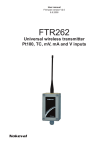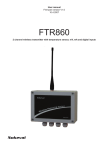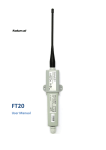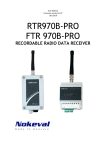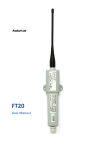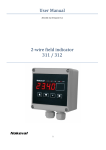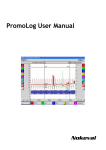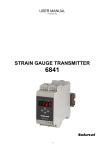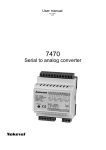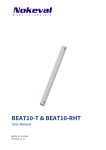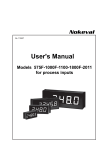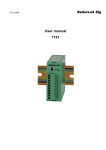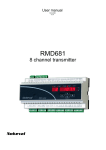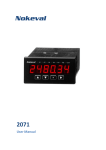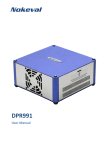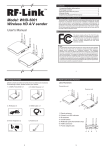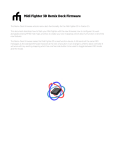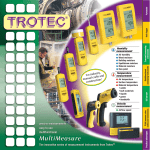Download RTR970B FTR 970B
Transcript
User Manual Firmare version V3.2 19.8.2010 RTR970B FTR 970B RADIO DATA RECEIVER DESCRIPTION RTR970B and FTR970B have only one difference, the case. The benefits in upgraded B version: Antenna is moved to the middle in both models and an USB- bus has been added to the FTR model. B version of FTR is also about half the size of the original. The device is a radio data receiver for Nokeval MTR series wireless transmitters. It receives and buffers the data packets which have been sent by MTR transmitters. It automatically recognizes the types of the transmitters, so different kinds of transmitters can be used simultaneously. Transmitters can also have different transmission intervals. The device uses license free 433.92 MHz frequency band (ISM) so it can be freely used, for example, almost in whole Europe. RTR970 is 35 mm DIN-rail mountable but desktop use is also possible. FTR970 is wall mountable. The receiver is connected to a computer using RS-485, USB or RS-232 bus and it requires PromoLog application that reads the information from the device. Nokeval SCL protocol is used for data transmission between the receiver and the computer. Multiple receivers can be connected in parallel to an RS-485 bus to increase the covered area. The receiver has three indicator LEDs and it requires 8…30 VDC or USB. covered area 2 CONTENTS DESCRIPTION ............................................................................................................................... 2 CONTENTS ...................................................................................................................................... 3 INSTALLING ................................................................................................................................... 4 Where to install ........................................................................................................................... 4 Connections .................................................................................................................................. 4 SETTINGS ...................................................................................................................................... 9 Connection settings..................................................................................................................... 9 Menutree..................................................................................................................................... 9 SCL-PROTOCOL.......................................................................................................................... 10 SPECIFICATIONS ........................................................................................................................ 11 3 INSTALLING WHERE TO INSTALL The RTR model is 35 mm DIN-rail mountable and FTR is wall mountable. Desktop use is also an option. The best place for a receiver is a big grounded horizontal metal level surrounded by as few as possible vertical metal surfaces. Antenna is to be installed perpendicular to the metal level with a corner piece or extension cord. The best range for the transmitter is achieved when there is a direct view from receiver to the transmitter. The walls and objects between the transmitters will dampen the signal and thereby shorten the range. On the other hand, metal surfaces cause reflections which might lengthen the range. CONNECTIONS USB-, RS-485-, or RS-232-bus can be used to connect the device via serial communications. Each of these connections will be covered in their own chapter below. By default, the device is jumpered to use the USB-bus. If RS-485 or RS-232 -bus is to be used, the serial bus needs to be jumpered differently. Open the case by pressing in the fasteners on both sides of the RTR970 case. The case of FTR970 is opened by removing the screws ANTENNA CONNECTION Antenna is attached to the BNC-connector by connecting the two locking pins, after which the ferrule at the foot of the antenna is to be turned 90 degrees clockwise. Antenna can be removed by turning the ferrule counterclockwise after which the antenna can be pulled off. USB To use USB-bus, jumper J11 has to be set as the picture below. Jumper J7 has nothing to do with using the USB -bus. The device is jumpered like this as default. The device gains the supply voltage through the USB, but to ensure that the device will operate while the computer is turned off, connect the supply voltage 8...30 VDC either by 1.3 mm DC jack (center connector positive) or by detachable screw post connector terminals 1 (+) and 2 (-). Both supply voltage connectors are internally connected. The receiver is protected against wrong polarity of the supply voltage. 4 RS-485 To use RS-485-bus, jumper J11 has to be set as the picture below. The supply voltage 8...30 VDC is connected using 1.3 mm DC jack (center connector positive) or by using detachable screw post connector terminals 1 (+) and 2 (-). Both supply voltage connectors are internally connected. The receiver is protected against wrong polarity of the supply voltage. The supply voltage's negative terminal is also used as ground for RS-485 and RS-232. If necessary RS-485 interface can easily be added to a computer by using Nokeval DCS770 or DC771B USB - RS-485 converter or RCS770 USB/RS-232-RS-485 converter. RS-485 bus is connected to terminals 3 (D1) and 4 (D0). If the master device in RS-485 bus has the common terminal, the ”two-wire” jumper must be set to ”no” position. If the master device doesn't have the common terminal, the jumper must be set to ”yes” position. If the device is the last device on the bus, it is recommended to set the ”term” jumper to ”on” position. When this jumper is set AC-termination is used which means that 1 nF capacitor and 110 ohm resistor are connected in series between the bus wires. Length of RS-485 bus can be 1km and it can be connected to 32 devices, more can be connected via repeating transmitters. RS-232 To use RS-485-bus, jumper J11 has to be set as the picture below. Jumper J7 has nothing to do with using the RS-232-bus. The supply voltage 8...30 VDC is connected using 1.3 mm DC jack (center connector positive) or by using detachable screw post connector terminals 1 (+) and 2 (-). Both supply voltage connectors are internally connected. The receiver is protected against wrong polarity of the supply voltage. The supply voltage's negative terminal is also used as ground for RS-485 and RS-232. RS-232-bus is not recommended since it is easily disturbed and the maximum length of the cord is only 15 meters in good circumstances. Long distances should be covered with RS-485-bus. 5 USB DRIVERS The USB interface chip needs two drivers: one for USB bus and the other to create a virtual serial port. The drivers can be obtained from a Nokeval Software CD or downloaded from the homepage of Nokeval at www.nokeval.com. The installation below assumes using CD, but using downloaded drivers is quite similar. Insert the Nokeval Software CD and plug in the device. Windows should detect it and start installing automatically: 6 7 When USB bus driver ftdibus.inf is installed, Windows wants to install the virtual serial port driver, which makes the device look like an ordinary COM port. Install in the same way as the bus driver. Finally it is necessary to find out, which COM port represents the device. Open Control Panel, System, Hardware, Device Manager. In the device tree, expand Ports, and there should be USB Serial Port (COM3), for example. 8 SETTINGS CONNECTION SETTINGS Use Mekuwin program to configure the device. You can download Mekuwin from Nokevals web site for free. Default communication settings for configuration: • speed 9600 baudia • protocol SCL • address 0 MENUTREE Menu of the device: SERIAL-SUBMENU (SER) Serial communication settings. Note that the changes here do not affect until the device is rebooted. Address: SCL address selection. Allowed addresses are 0...123. Baud: Baud rate selection. Options are 300, 600, 1200, 2400, 4800, 9600 and 19200. RECEIVE-SUBMENU (RCV) CRCChk If selected, CRC checksum of received data packets is checked and corrupted packets are rejected. The setting is on by default and there is no reason to disable the setting. CH1ID...CH4ID Four MTR series transmitters (except MTR260 and FT10) can be defined to act as certain channel. For example, when the device receives ”MEA CH 1?” command it sends latest received data from the transmitter that has been assigned to channel one. To assign a device to channel one, set the transmitter's ID to CH1ID value. Other channels can be assigned in the same way. 9 SCL-PROTOCOL A more detailed description of the Nokeval SCL protocol can be downloaded from Nokeval wwwpages. Some additional commands have been added to SCL protocol for MTR and RTR series devices that are not covered by the general SCL manual. These commands are explained in the list below. Device supports the following SCL commands: TYPE ? Returns the model name and software version. SN ? Returns the device's serial number, for example ”A123456” MEA CH X ? Returns the last received value from the device that is defined as ”channel x”. DBG 1 ? Returns the oldest unread data packet from the buffer. DBR 1 XX ? Returns a data packet from the ring buffer location xx. DBX Clears the ring buffer. DBS 1 ? Returns the size of the ring buffer. 10 SPECIFICATIONS Radio receiver Environment Antenna Connector: 50 Ω BNC female connector Standard antenna: helical whip antenna (BNC connector) Radio Operating temp.: Protection class: Max input power: +10 dBm Frequency band: license free 433.92MHz sub band e according to ERC/REC 70-03 Bandwidth: 180 kHz Selective filter: Yes, SAW type Sensitivity: -100 dBm (3·10-3 error ratio) Decoder Buffer memory: 96 latest transmissions RS: RF: Power: Serial connections Dimensions RS-485 Connector: RTR970B: 70 x 85 x 60 (WHD) FTR970B: 80 x 130 x 60 (WHD) Antenna: 100 mm, Ø 14 mm Protocol: Baud rates: RS-232 Connector: Protocol: Baud rates: USB Connector: Protocol: Baud rates: Detachable screw post connector with 3.5 mm raster, combined with power supply, terminal 3 D1, terminal 4 D0. Maximum cable length is 1000 m Nokeval SCL 300/600/1200/2400/ 4800/9600/19200 Detachable screw post connector with 3.5 mm raster, terminal 6 TxD, terminal 7 RxD. Maximum cable length is 10 m Nokeval SCL 300/600/1200/2400/ 4800/9600/19200 USB type B, female Nokeval SCL 300/600/1200/2400/ 4800/9600/19200 Supply voltage Connector 1 Connector 2 Connector 4 Voltage: -30...+60 °C RTR970B: IP20 FTR970B: IP65 LEDs Serial bus indicator Radio receiver indicator Power indicator (behind RS and RF LEDS) Settings Connection: Protocol: Software: RS-232/485 or USB Nokeval SCL-Meku 1 Mekuwin for Windows 98...XP Regulations EMC directive EMC immunity EMC emissions R&TTE directive EN 300 220 class 3 EN 300 489 EN 300 339 EN 61326 EN 61326, class B 1.3 mm DC-jack, center positive detachable screw port connector with 3.5 mm raster, terminal 1+, terminal 2 -USB type B, female 8...30 VDC 11 Manufacturer Nokeval Oy Yrittäjäkatu 12 FIN-37100 Suomi 12 Tel +358 3 3424800 Fax +358 3 3422066 www.nokeval.com Sales: [email protected] Technical support: [email protected]












